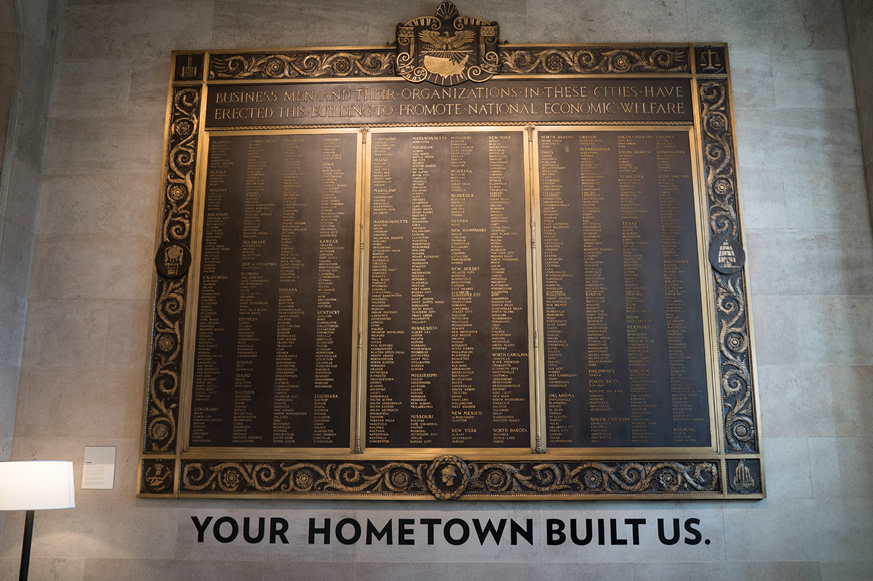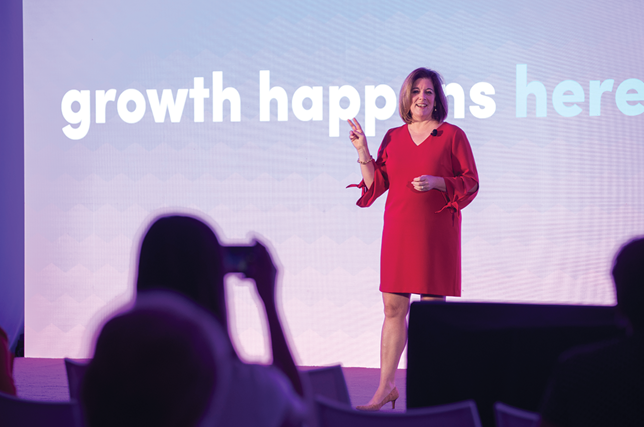- Home
- Media Kit
- Current Issue
- Past Issues
- Ad Specs-Submission
- Ad Print Settings
- Reprints (PDF)
- Photo Specifications (PDF)
- Contact Us

![]()
ONLINE

Job Creation
and Economic Growth
Editors’ Note
Suzanne Clark leads a wide range of policy and operational initiatives at the U.S. Chamber of Commerce. Prior to re-joining the U.S. Chamber in 2014, where she had previously served as chief operating officer, Clark acquired and led a prominent financial information boutique, Potomac Research Group, before selling the firm to a larger macro-research organization where she is a non-executive partner. In 2007, Clark was named president of the National Journal Group, a premier provider of information, news and analysis for Washington’s political and policy communities. Clark sits on the boards of two public companies, AGCO, a Fortune 500 global leader in the design, manufacture and distribution of agricultural equipment, and TransUnion, a provider of global risk and credit information. She is also a member of the board of So Others Might Eat, serving the poor and homeless in the nation’s capital, and St. Patrick’s Episcopal Day School. She is the former president of the International Women’s Forum (Washington Chapter), a global group of leading women in business, law, government, technology and the arts. Clark was named one of Washingtonian magazine’s “40 Under 40: Young Washingtonians to Watch,” and later, one of the magazine’s “100 Most Powerful Women in Washington.” Clark earned a B.A., magna cum laude, and an M.B.A. from Georgetown University.
Organization Brief
The world’s largest business advocacy federation, the U.S. Chamber of Commerce (uschamber.com) represents the interests of more than 3 million businesses of all sizes, sectors, and regions, as well as state and local chambers and industry associations.

A 12-foot-high bronze plaque at the
U.S. Chamber of Commerce headquarters honoring those
small business leaders who built the organization
Will you highlight the U.S. Chamber of Commerce’s history and how the Chamber has evolved?
In 1912, hundreds of local chambers from across the country came together at the behest of President Taft to create a national voice for business in Washington.
The concept was to determine what it would look like to have a national organization that cared about job creation and economic growth the way small business leaders do at the local level. As a tribute to them, we placed in the lobby of our headquarters a 12-foot-high bronze plaque that honors the vision and contributions of the small business leaders who literally built this organization from the ground up. This plaque inspires me every day. We have sat at that same table of job creation and economic growth for more than 100 years.
While that focus remains consistent, our tactics on how to achieve this has evolved. What that means in any one period of time changes. The things you have to transform are the strategies, tactics, mechanisms and listening posts, while also staying really focused on that true north of why and how you were founded as a federation for the business community. That helps not to change the things in your past that you shouldn’t, and it helps you hold tight to a legacy that gives you meaning, purpose and guardrails.
How is the Chamber addressing the issues of job creation and economic growth today?
I think the most important thing is that every senior person here is required to get outside of the Beltway pretty often to talk to people running businesses. Whether that’s a person with a few employees or a Fortune 10 executive, you really find that the CEO point of view has a lot in common. When I travel the country and even globally, I ask what is it that keeps you from creating the next job? What is it that keeps you from furthering the economy? What could we do to help you?
The number one thing we hear about is talent. Pick your industry, pick your geography, pick your size, it’s either we need more skilled immigration or it’s we need different skilled workers than we have. Those conversations make it clear that the education system isn’t producing exactly what we need and we lack workers. That combination of factors has created a situation where we have more jobs than we have people. To grow businesses and provide opportunities in a community, CEOs are worried about where that next really great, qualified employee is going to come from.
The number one thing we hear about is talent.
Pick your industry, pick your geography, pick your
size, it’s either we need more skilled immigration or it’s we need different skilled workers than we have. Those conversations make it clear that the education system isn’t producing exactly what we need
and we lack workers.
When you are dealing with these types of long-term challenges and complex issues, what is the approach the Chamber is taking to drive results?
It is multi-pronged. That’s where the federation at our root is so valuable because I think the most helpful thing we do is get into specific communities and help them solve this at a local level.
We are running talent pipeline academies in 30 states and Canada. We help train local leaders to run a supply chain type effort where you get the employers in a community together to say this is the type of person we need and could hire. You then turn to the educational outlets whether that’s a community college or a technical school or a high school or a college and say this is what you have to produce to make sure that people coming from your school will end up employed.
That has to happen on a grassroots community level because they’re so different. That said, those talent pipeline academies have been very successful because they’re based in the federation and in specific communities.
There are broader issues of how we’re financing education today. What does that look like? The U.S. Chamber Foundation is launching a yearlong project called Talent Finance to look at innovation. We believe at our core in innovation and ingenuity, but the fact is that right now the country is divided into two camps.
One camp says I’m really hopeful about the future. I’m really excited about technology and innovation. I believe in the human spirit and human ingenuity and humans’ ability to solve problems and do things. I’m excited about that creation. Sure, I see some problems, but I believe we can fix them.
There’s another camp that says people are selfish and grounded in their self-interest. Businesses are grounded in their self-interest. They’re only out to make a buck and what we really need is a huge government apparatus and control to fix the problems that exist in society today.
You don’t work at the Chamber of Commerce unless you believe in the former. We believe human spirit, human ingenuity, and innovation ends up tackling problems. We’re not in the camp that says government is going to be the most innovative and have the best and biggest solutions.
Will you discuss the Chamber’s leadership and strength around research, data and metrics?
I think one of the examples that I would give you is when tax reform was beginning. We were lucky in that we have a woman named Caroline Harris here on the team who had for years been working with companies large and small across industries and across geographies about the potential impacts of different types of tax reform. So when there was a moment in time that tax reform could happen, having that level of expertise and deeply researched positions about potential impacts, pros and cons, of different types of movements was extraordinarily helpful to the Hill. Here’s where having deep expertise in research matters.
We’re also conducting research and getting real stories and telling stories in a way that helps bring people along. We produce things like the MetLife index about the health of small businesses and what their views are of the economy. We do a great Commercial Construction Index with USG that surveys people all across the country about their pipeline as a way to try to predict where commercial construction is going. These indices have been deeply helpful, both for specific industries or segments, as well as for press coverage and telling stories and bringing advocates along. They’re all really important to our work.
We have policy expertise, conduct research, and host events. We do about 2,000 events a year and that could be a head of state who is in town or convening local chamber fly-ins to meet their members of Congress and their staff. This idea of convening and having people in one place, face-to-face, having dialogue and sharing experiences on the issues that are confronting communities across the country, is probably our biggest strength.
Will you highlight the Chamber’s efforts around diversity and inclusion?

Suzanne Clark teaching at a
U.S. Chamber of Commerce Small Business Master Class
It’s crucial for a whole bunch of reasons. For one thing, if we want to represent all of business then we have to be able to tap into the thoughts and points of view of all types of businesses and all types of geographies.
Second, if we want to have the best talent in the country, this talent doesn’t all look the same or sound the same or have the same education, so diversity of thought is really important.
When we go to hire, we go to our own networks first, whether that’s our alma mater or people we know. So it’s been an important challenge for us to broaden our network to figure out where we can get the next generation of thought leaders and engage them in our work.
We have had a majority female management committee for a long time. We have had a really global workforce for a long time. International is our biggest division and we sometimes sit at staff meetings and as our people are introduced about which languages they speak, I’m like, “Oh my God, I would never get a job here.”
We’re working now on increasing the number of African American employees that we have. We are doing that, in part, through a partnership with Howard University. We just added Howard’s president to our board. We’re also doing it by saying you should hire the best person for the job, but not until you see it diversely.
Another piece has been millennials and 50 percent of our workforce at the Chamber is millennials. Thinking about how the next generation of entrepreneurs is going to start businesses starts right here at home.![]()